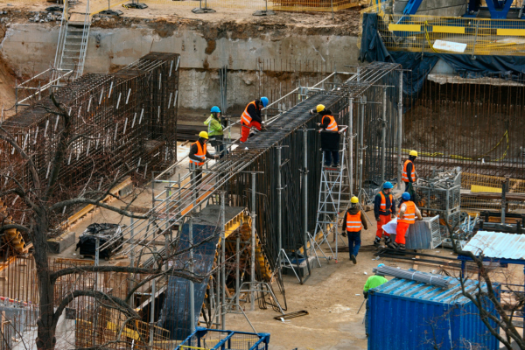
The Role of BIM in Automating Construction Site Operations
Introduction
Construction projects today face growing pressure to be faster, cheaper, and more efficient. Traditional processes often struggle to meet these demands. Manual workflows and outdated methods lead to delays, miscommunication, and increased costs. These challenges slow progress and make it hard to stay on budget or schedule.
This is where Building Information Modeling (BIM) comes in. BIM is changing the game by automating many construction tasks. It provides real-time insights, streamlines operations, and improves decision-making. With BIM, teams can manage schedules, resources, and risks more effectively.
BIM isn’t just a new tool—it’s a global shift in how construction is managed. From planning to execution, BIM’s impact is felt across projects of all sizes. It is helping companies around the world complete projects faster and with fewer mistakes. BIM is driving a new era of smarter, more efficient construction practices.
The Current Landscape of Construction Operations
Construction sites still rely heavily on manual processes. Tasks like scheduling, resource allocation, and communication are often done by hand. These traditional methods are slow and prone to errors. As a result, projects face frequent delays, cost overruns, and miscommunication between teams.

Stakeholders often struggle to stay on the same page. Plans may change, but updates don’t always reach everyone in time. This creates confusion and leads to mistakes that are expensive to fix. Manual workflows also make it harder to track progress and ensure quality.
Automation offers a solution to these problems. By streamlining processes and improving communication, it can save time and reduce costs. Automated systems keep everyone updated in real time, helping projects run more smoothly. With the right tools, construction sites can shift from reactive problem-solving to proactive management, creating more efficient and reliable operations.
Understanding BIM’s Role in Automation
Building Information Modeling (BIM) is a digital process that transforms how construction projects are planned and managed. It creates a shared, 3D model that contains detailed information about a building’s design, structure, and systems. This model serves as a central hub for all project data, ensuring teams have accurate and up-to-date information.

BIM’s core functionalities go beyond just visualizing a structure. It integrates design, scheduling, and project management into one platform. This makes it easier to coordinate tasks, allocate resources, and monitor progress. For example, a design change in BIM updates schedules and material quantities automatically, reducing manual work and potential errors.
BIM and automation work hand in hand. Automated workflows, powered by BIM, streamline repetitive tasks like clash detection and quantity takeoffs. Real-time updates ensure everyone is working with the latest information, improving communication and decision-making. By integrating these features, BIM simplifies complex processes and reduces delays. It allows construction teams to focus on problem-solving and innovation rather than administrative tasks. With BIM, automation becomes a practical and powerful tool for enhancing efficiency and ensuring project success.
Key Applications of BIM in Automating Construction Operations
BIM offers practical solutions that simplify construction operations through automation. Its applications range from scheduling to risk management, making projects faster, smoother, and more efficient.
Automated Scheduling and Resource Allocation: BIM helps create accurate, real-time schedules. When a task is delayed or a design is updated, BIM adjusts timelines and resource plans automatically. This ensures labor, materials, and equipment are allocated efficiently, reducing waste and keeping projects on track.

Site Monitoring and Reporting: By integrating with IoT and AI, BIM enables real-time monitoring of construction sites. Sensors collect data on progress, safety, and environmental conditions, which is then visualized in BIM. Automated reports provide instant updates, helping managers address issues quickly and stay informed without manually gathering information.
Streamlining Communication and Collaboration: BIM acts as a central data hub, allowing stakeholders to access and share the same information. This eliminates the confusion caused by outdated plans or missed updates. Teams can collaborate seamlessly, reducing delays and improving decision-making.
Clash Detection and Risk Mitigation: BIM’s clash detection tools automatically identify conflicts between systems, such as plumbing and electrical layouts. By addressing these issues during the planning stage, BIM prevents costly mistakes and construction delays. It also helps assess risks early, ensuring safety and efficiency.
With these capabilities, BIM transforms construction operations, providing teams with the tools to work smarter and achieve better results.
Benefits of BIM in Construction Automation
BIM brings significant benefits to construction automation, making projects faster, cost-effective, and safer.
Increased Efficiency: Automation through BIM speeds up project timelines. Automated workflows handle repetitive tasks like scheduling and quantity takeoffs, saving time and reducing human errors. Teams can focus on strategic decisions rather than administrative work, helping projects stay on track.

Cost Reduction: BIM helps optimize resources by accurately calculating material quantities and minimizing waste. With better resource planning, unnecessary expenses are avoided. Automated updates ensure that budgets align with real-time project needs, reducing financial surprises.
Enhanced Decision-Making: BIM provides data-driven insights that empower better decision-making. Real-time data and simulations help managers predict outcomes and plan effectively. This leads to smarter choices about design, materials, and scheduling, ultimately improving project outcomes.
Improved Safety: Automation through BIM identifies hazards early, reducing risks on-site. Tools like clash detection prevent dangerous errors in design, while real-time monitoring ensures safety protocols are followed. By addressing risks before construction begins, BIM creates safer working conditions.
With its ability to improve efficiency, cut costs, and enhance safety, BIM is a game-changer for construction automation. It not only solves today’s challenges but also sets the foundation for future innovation in the industry.
BIM and Emerging Technologies
BIM becomes even more powerful when integrated with emerging technologies like AI, robotics, and IoT. AI enhances BIM by analyzing vast amounts of data to predict project outcomes, optimize schedules, and identify risks early. Robotics streamlines construction tasks, such as material handling and precision assembly, improving efficiency and reducing human error. IoT connects devices on-site, providing real-time updates on progress, equipment performance, and safety conditions, all visualized in BIM.

These technologies elevate BIM’s capabilities, enabling advanced automation and smarter decision-making. Together, they pave the way for innovative construction practices, such as predictive maintenance, autonomous equipment, and real-time collaboration. By combining BIM with cutting-edge tools, construction teams can achieve unprecedented levels of efficiency, accuracy, and safety.
The Future of Construction with BIM
The future of construction lies in advanced technologies, and BIM is at the center of it all. Digital twins, virtual replicas of physical structures, will allow real-time monitoring and predictive maintenance, ensuring buildings operate efficiently. Predictive analytics powered by BIM will help foresee delays, cost overruns, and safety risks, enabling proactive solutions. Fully automated construction sites, with robots and AI-driven systems, will further revolutionize workflows, reducing human error and speeding up projects.

BIM remains the cornerstone of these innovations, serving as the foundation for smarter, data-driven construction practices. As technology advances, BIM’s role will only grow, ensuring the industry keeps pushing boundaries and embracing the future with confidence and precision.
Conclusion
BIM’s automation capabilities tackle key construction challenges like inefficiency, delays, and high costs. By streamlining workflows, optimizing resource use, and improving communication, BIM transforms how projects are managed. Its integration with emerging technologies drives innovation, paving the way for smarter, safer, and more cost-effective construction practices.
BIM is more than a tool; it’s a necessity for staying competitive in today’s fast-paced industry. Construction professionals must embrace BIM to achieve better outcomes and future-proof their operations. Start leveraging BIM now to unlock its full potential and lead the way in smarter construction management.